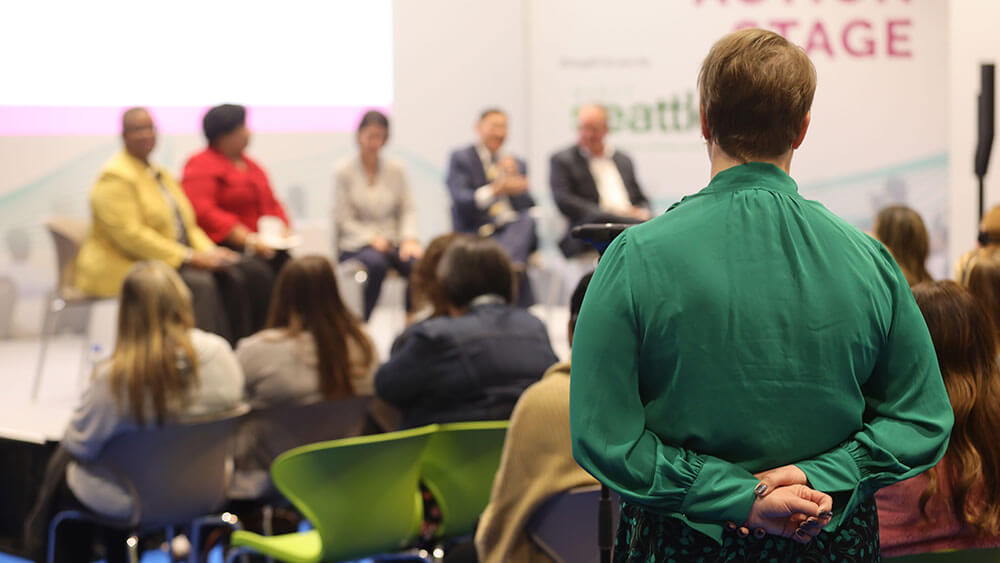
An attendee at Convening Leaders 2020 asks her question during a session. At scientific conferences, the number of female attendees who ask questions is lower than that of their male counterparts. (Jacob Slaton Photography)
At the 2019 Annual Meeting and Exposition of the American Society of Hematology (ASH), held last December in Orlando, half of the speakers and moderators were women. That’s a significant bump up from the average at U.S. medical meetings — according to a study published last year in JAMA Network Open, the average proportion of female speakers at U.S. medical meetings is one-third. However, based on a comparative analysis of the behavior of men and women at the ASH conference, increasing the number of women speakers and moderators wasn’t enough to raise the level of women’s participation at the conference in every way. By one measure — the number of questions asked — men were more likely to have a voice at the conference.
Speaker and moderator are only two of the roles that are professionally important to participants at scientific conferences — there’s also the role of questioner, point out the authors of an article recently published in the ASH medical journal, Blood Advances. And on that count — when researchers analyzed a random selection of plenary and other sessions at the ASH conference, looking at how often men and women asked questions at the event — female participation at the ASH meeting fell sharply. Of the meeting’s nearly 30,000 attendees, 39 percent were women, but only 23 percent of those who asked questions were female.
That matters, the study’s authors wrote, because of the positive effect that asking questions can have on the visibility and careers of conference participants. “Publicly asking a question provides professional visibility to the question-asker,” they wrote. “Asking a clearly articulated, insightful question to the presenter in front of a large audience … gains the attention of the moderator and speakers as well as the audience.”
That positive impression may not confer to virtual events, according to the article’s authors, who include Bill Reed, FASAE, CMP, chief event strategy officer at ASH. “This mechanism of question asking may become more popular with greater technological capacity and the robust advent of virtual conferences and symposia,” they write, “but it does not afford the questioner the same professional recognition, even if the moderator states the questioner’s name.”
In their analysis of who asked questions at the conference and when, researchers also uncovered conditions in which women were most likely to speak up — women were more likely to ask questions, they discovered, if another woman asked the first question. This means, the authors write, that conference organizers could engineer ways to encourage more women to ask questions. This includes adopting such policies as deliberately giving the first question to a woman during Q&A.
The study didn’t include an analysis of questions asked among online participants, but gender disparities become even more striking online than at in-person meetings, according to Deborah Tannen, a professor of linguistics at Georgetown University who has been studying the differences in the ways men and women speak for decades. While Tannen wasn’t referring specifically to question-asking at online conferences in a New York Times column published earlier this year, her research yields insights as to why women are less apt to speak up in general at both in-person and online meetings. Tannen noted that many of the inequities in meetings have to do with gender differences in conversation styles and conventions. “Women often feel that they don’t want to take up more space than necessary so they’ll often be more succinct,” she said, whereas men tend to speak longer and they can be more critical in order to be seen as authoritative.
The authors of the ASH study didn’t offer a similar explanation for their findings, saying that “what motivates or prevents people from asking questions publicly is unknown.” But, they added, question-asking can be viewed as a skill — one “that can be taught, practiced, encouraged, and modeled.” The ASH data clearly demonstrates that “when a woman asked the first question, other women were more likely to ask questions after her.”
Their conclusion: “People who control question-asking can support more women asking questions by calling on them first, endorsing their questions, encouraging additional questions from the audience, and giving women the space and time to ask questions.”
Barbara Palmer is deputy editor at Convene.
